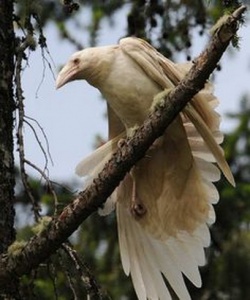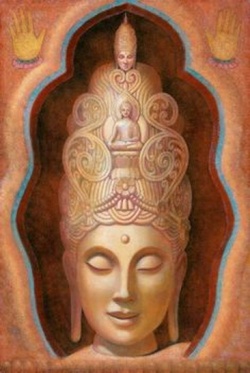Difference between revisions of "Raven"
(Created page with "<poem> Edgar Allen Poe's The {{Wiki|Raven}} (1845) sits eternally "On the pallid bust of Pallas" -- that is, a pale marble head-and-shoulders of Athena, {{Wiki|Greek}} godde...") |
|||
| Line 1: | Line 1: | ||
| − | <poem> | + | <poem>[[File:1cberr0e4.jpg|thumb|250px|]][[File:818g86_m.jpg|thumb|250px|]][[File:3b4cyj4d4.jpg|thumb|250px|]] |
Edgar Allen Poe's The {{Wiki|Raven}} (1845) sits eternally "On the pallid bust of Pallas" -- that is, a pale marble head-and-shoulders of Athena, {{Wiki|Greek}} [[goddess of wisdom]]. [Pallas refers to her special cloak.] The bird's message, "Nevermore" is a powerful reminder of [[impermanence]] which motivates us to seek and attain [[wisdom]]. However, this largest black {{Wiki|bird}} is also seen as a creator and [[protector]]. | Edgar Allen Poe's The {{Wiki|Raven}} (1845) sits eternally "On the pallid bust of Pallas" -- that is, a pale marble head-and-shoulders of Athena, {{Wiki|Greek}} [[goddess of wisdom]]. [Pallas refers to her special cloak.] The bird's message, "Nevermore" is a powerful reminder of [[impermanence]] which motivates us to seek and attain [[wisdom]]. However, this largest black {{Wiki|bird}} is also seen as a creator and [[protector]]. | ||
{{Wiki|Raven}} | {{Wiki|Raven}} | ||
Revision as of 10:48, 21 November 2013
Edgar Allen Poe's The Raven (1845) sits eternally "On the pallid bust of Pallas" -- that is, a pale marble head-and-shoulders of Athena, Greek goddess of wisdom. [Pallas refers to her special cloak.] The bird's message, "Nevermore" is a powerful reminder of impermanence which motivates us to seek and attain wisdom. However, this largest black bird is also seen as a creator and protector.
Raven
Among the aboriginal peoples of the Pacific northwest coast of North America, the Master of Life takes the form of a raven. It is Raven who welcomes humans as they emerge from a pea pod or a clamshell. In a different cycle of myths, it is Raven who swallows the Moon, and he insinuates himself into the world of human beings by transforming into a mere pine needle.
The Bible (Genesis, chapter 8: 6-13 of the Old Testament) tells how birds are sent by Noah to detect whether there is any dry land outside the ark that he had built to withstand the Flood:
At the end of forty days Noah opened the window of the ark which he had made, and sent forth a raven; and it went to and fro until the waters were dried up from the earth.
Then he sent forth a dove from him to see if the waters had subsided from the face of the ground; but the dove found no place to set her foot and she returned to him to the ark, for the waters were still on the face of the whole earth. So he put forth his hand and took her and brought her into the ark with him. He waited another seven days and again he sent forth the dove out of the ark; and the dove came back to him in the evening, and lo, in her mouth a freshly plucked olive leaf; so Noah knew that the waters had subsided from the earth. Then he waited another seven days, and sent forth the dove; and she did not return to him any more.
It is revealing that the raven (Corvus corax) is sometimes viewed as an evil bird since it did not immediately return, but the "to and fro" of the above Revised Standard Version seems to indicate that it was engaged in its proper "housekeeping" activities as carrion bird.
In Tibet, as among the aboriginal people of North America, the raven is seen as a most auspicious bird, and other black birds, and other carrion birds, benefit from this association. A raven indicated to the Fourth Sangye Nyenpa the location for Benchen Monastery that is named for the protector, Mahakala Bernachen. This is the Shing Kyung that is the protector of Benchen. In consideration of this, Very Venerable Tenga Rinpoche possesses a tangka of Shadbhuja [Six-armed] Mahakala received by his previous incarnation from Jamgon Kongtrul the Great.
The hat of office of the Bhutanese high lama has the effigy of a raven at its crown.
Ngawang Thondup Narkyid in Life in the Potala says that the ravens " . . . would gather together in assembly, almost like human beings, to talk and play and, like us, to compete in different kinds of sports! . . . . We'd shape small balls of tsampa dough and toss them up in the air for the ravens to catch and eat. . . . . Though they didn't actually let us touch them, we could get very close, and they would take food from our fingers. Most of the monks and students had a raven friend."
Ravens, the largest and most impressive of the Corvidae, are also kept in Gibraltar and at The Tower of London, where their well-being is associated with that of the British monarchy and once, the Empire.
Crow
The crow, like the raven, is associated with Mahakala, the Tibetan protector of Buddhism.
Hindu two-headed deva, Shani, (astrologically equated with the planet Saturn) is depicted seated on a crow. He protects against thievery, a quality for which the crow is well-known.
When the home of the baby who was to become known as the First Dalai Lama Chokey Geundun (or, Kundun which means "the presence") was set upon by raiders, the family had to flee leaving behind the little child. When they returned the following morning, they found the baby guarded by a pair of crows.
To this day, they are associated with that Lama and figure among the symbols of his rank. In Kundun (Martin Scorsese, 1997) the film made of the first 25 years of the current (14th) Dalai Lama's life, based upon a series of interviews conducted by Martha Mathison, Reting the Regent tells how on the morning following the birth, the mother noticed a pair of crows outside.
The Indian kite, whose harsh cries are heard in the morning in cities, is a kind of crow.
Many myths tell how the crow was once a white bird, but was punished for some wrong-doing and its feathers became black, often through burning.
The magpie is a member of the corvid or crow family. Pied means alternately marked or colored, in this case black and white.
In English, to eat crow means to be humbled.
Raven, crow, jay and magpie calls.
Crow Augury, a Tibetan form of divination (scroll down the page just past the "J. Crow" seal.
The Difference
The raven [at the right] is an enormous bird compared to the ordinary crow [middle bird.] Like the vulture, it also relies heavily upon carrion. Though not as high on the food chain as the vulture, nor with as much body fat in which pesticides collect, it is also a threatened species.
In the above Canadian wildlife research photo, all 3 birds were found to have died from West Nile virus. Treat birds with respect, especially now that another dangerous bird virus -- influenza A(N5H1) -- has been found. Avoid handling dead birds with your bare hands, and always wash your hands well after handling and or refilling outdoor bird feeders.


